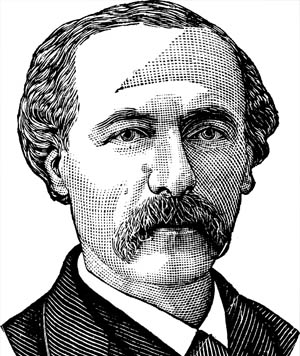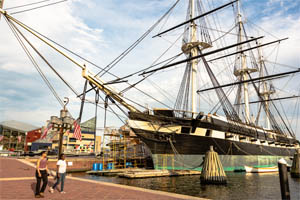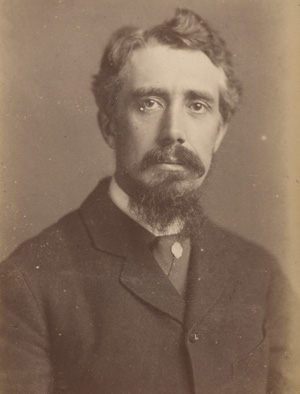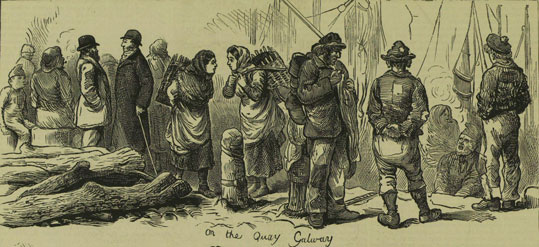THE AMERICAN DOLLARS THAT SAVED IRELAND IN 1880
Published in Features, Issue 6 (November/December 2022), Volume 30By Evan Comerford

Above: Journalist James Redpath—provided vivid descriptions in New York’s Tribune newspaper of the misery in Ireland and urged the US to send help.
‘The present famine, as all other famines in Ireland, has been the direct result of the system of land tenure which is maintained there’
(Charles Stewart Parnell, address to US House of Representatives, Washington, 2 February 1880).
In 1879 Ireland was on the brink of famine once more. A succession of poor harvests brought on by bad weather and a sharp fall in prices created much hardship and hunger, particularly in the West. Evictions rose to rates not seen since the Great Famine of the 1840s, and emigration to America reached 84,000 in 1880. The Land League, a movement formed in Mayo in 1879, achieved massive support and very quickly became a national movement, led by Michael Davitt and Charles Stewart Parnell. A huge campaign was initiated to gather funds from the Irish abroad to relieve the famine-like conditions in Ireland. Famine relief was the primary objective of diaspora fund-raising and much of the money was raised independently of the land movement, but it overlapped with the nationalist politics of the Land League and the Irish Parliamentary Party, particularly through the actions of the charismatic Charles Stewart Parnell. The campaign tapped into the emotive potential of Irish emigrants and rallied the ‘Global Irish’ to come to the aid of their homeland.
A STATE OF DISTRESS
The years leading up to the Land War had been relatively prosperous for the agrarian economy. Farmers received good prices at market day and there had been a gradual rise in rural living standards across areas like housing, education and diet since the 1850s. Nevertheless, the lion’s share of progress in those years of prosperity had been enjoyed by the strong middle-class farmers. Benefits to the small farmer and ‘landless’ labourer class were minimal, and counties such as Mayo, Galway, Donegal and parts of Cork were left on the verge of destitution when the economy started to turn.
The winter of 1879 was the coldest in living memory. Farm incomes were hit badly as prices for cattle and sheep dropped. Heavy rainfall before the harvest hit the potato crop hard. Unlike during the Great Famine, the loss of the potato crop was not the sole cause of distress. Remittances from seasonal farm labourer migration to Britain decreased by £250,000 in 1879, owing to a decline in demand caused by an influx of cheap American grain into Britain. On Achill Island, returns from seasonal migration were one sixth of the previous year’s, a loss of about £10,000.
In Cork, those worst affected were reduced to one meal a day for several months, which caused a large increase in disease arising from malnutrition. The crisis also caused a sharp increase in the numbers seeking Poor Law relief in the county, from 10,800 in 1878 to 16,400 by March 1880. The lord lieutenant, the Duke of Marlborough, received 291 requests for relief from across the country in the last five months of 1879. In Cahersiveen a local government inspector observed that people from the town had besieged the court-house in an effort to seek relief. The parish priest in Louisburgh, Co. Mayo, reported that the poor roved around his house and the chapel yard ‘moaning and wailing’ for relief.
These conditions naturally left the poorest struggling to pay their rent, and the unwillingness of landlords to grant rent reductions was the catalyst for the land agitation that followed. The newly formed Land League had ambitions to start a national land movement and achieve improved conditions for tenant farmers, but their immediate objectives in 1879 were focused on raising funds for famine relief in the most distressed parts of the western seaboard. Parnell, now leader of both the Land League and the IPP following the death of Isaac Butt, called for relief funds in Westminster, but to no avail. The government’s hesitation to introduce emergency legislation meant that poor relief was largely left to local charities and hastily organised relief committees who were desperately in need of funds.
PARNELL AND THE LAND LEAGUE CAMPAIGN IN AMERICA

Above: The USS Constellation docked in Baltimore, Maryland, in July 2017. On 27 March 1880 it was dispatched to Ireland with more than 3,300 barrels of foodstuffs, plus articles of clothing.
In January 1880, Parnell, John Dillon and Michael Davitt sailed across the Atlantic for a three-month tour of North America. Over the course of their 62 stops, awareness grew among the American public of the famine-like conditions in Ireland. The New York Tribune, in particular, gave significant coverage to the famine during 1879 and 1880 with the help of journalist James Redpath, who provided vivid descriptions of the misery in Ireland and urged the US to send help.
The conditions in Ireland struck a chord with the American public and seemed to awaken a sense of duty to assist this old-world nation. Parnell became the focus of that outpouring of sympathy towards Irish famine relief. Such was the prominence of Parnell’s visit in America that the Irish Times reported that ‘For some days his policy and his programme had been the subject of almost universal conversation’. Parnell’s initial reasons for touring America were focused solely on promoting the Land League and its agrarian aims to Irish-Americans, but the relief campaign presented him with an opportunity to address a broader American audience about Ireland’s woes and he grasped it.
Irish-American newspapers also played an important role in collecting money for famine relief. Parnell designated the Boston Pilot newspaper, edited by the old Fenian John Boyle O’Reilly, to coordinate the sending of funds back to Ireland, and $95,000 had been sent back by the Pilot by April 1880. Patrick Ford, an emigrant from Galway and the editor of the New York-based Irish World, was instrumental in raising funds in America for the Land League during this period and would continue to do so during the Land War and beyond. The New York Herald also started a fund for the relief of distress in Ireland; their editor and owner Gordon Bennett personally donated $100,000.
At his lectures, Parnell told his audiences that the conditions in Ireland were a direct consequence of the system of land tenure. He appealed to the Irish in America to help end the conditions that forced them to send remittances home to their families, telling them in Boston: ‘From statistics that I have been enabled to collect since I have been in this country, I find that at least one-sixth part of the rent which has been paid to landlords of Ireland has been paid by Irishmen and women living in America’. Those attending his lectures were more than generous when it came to donating to the relief cause; probably $300,000 was pledged directly at the lectures. Of the money raised directly by Parnell, at least 80% of it went directly to charity in Ireland, with the remainder going towards funding the Land League.
Parnell addressed the House of Representatives in Washington DC on 2 February 1880, following which another $500,000 was pledged to Ireland by Congress. On 27 March 1880, the US Department of the Navy dispatched the USS Constellation to Ireland with more than 3,300 barrels of foodstuffs, as well as articles of clothing. The Herald covered the Constellation story on a daily basis, right up to the ship’s landing in Queenstown in April 1880. Parnell’s visit and the publicity generated from it raised vital awareness among Irish-Americans and the wider American public of the dire situation that was emerging in Ireland.
A GLOBAL IRISH EFFORT
More again was raised by Catholic dioceses across the US and Canada through donations from individuals to their local churches. Most of this money was sent directly to bishops in Ireland, who passed it on to local relief committees; often US Catholic parishes pooled their money and sent it directly to a bishop in Ireland. One Irish emigrant wrote to his cousin in Carlow in 1880, saying: ‘Do you ask or get any of this money that is being sent every day. There is not a church in America but has had a collection taken for Ireland. Very thankful for those papers, it is a terror to read of destitution.’ Contributions came in from across the Irish-American strongholds of Boston, Philadelphia and Chicago, where undoubtedly the memory of the Great Famine among surviving Irish emigrants and their children created an outpouring of sympathy and charity through countless small donations. At one of Parnell’s public meetings, the mayor of Boston, Frederick Princes, introduced him to the crowd, saying, ‘He will tell you a story of the sorrow and sufferings, the wrongs and troubles of Ireland, but we have long been familiar with that sad story’.
The famine relief campaign of 1879/80 also harnessed the huge Irish presence outside the United States. Canadians, for example, gave tens of thousands of dollars. Australia and New Zealand far exceeded this by contributing about half of the Mansion House fund (nearly £90,000) that had been set up by the lord mayor of Dublin, Edmund Dwyer Gray. For the Irish of those southern hemisphere islands it marked their first significant aid to their land of origin. Argentina, South Africa and India also were sources of significant remittances. In England, the Duchess of Marlborough established a fund that raised £135,000.
Most of the money raised was put towards the purchase of food and clothing for those in distress, with some going towards relief work projects intended to provide employment. Dispersal of the funds, aside from money sent directly from one family member to another, was left to local relief committees; at least 800 such committees were formed across Ireland under the Mansion House fund alone. Cormac Ó Gráda estimated that the total amount raised during this period was around £800,000 in private charity and up to £2.4 million in government aid, a figure larger than the £1.2 million in rent reductions that was granted to tenants via the Land Commission courts in 1881.
SAVING THE HOMELAND

Above: Edmund Dwyer Grey, lord mayor of Dublin, who set up the Mansion House fund, which distributed relief countrywide through 800 local committees.
Perhaps the reason why the ‘Little Famine’ of 1879/80 was mostly forgotten in Irish history was that prolonged hunger and distress never materialised. By the summer of 1880 early signs of a better potato harvest indicated that the worst had passed and that famine had been avoided in Ireland. Deaths directly linked to hunger or malnutrition were few. Historian Kerby Miller attributed this to the Irish-American relief money that ‘flooded the island’ in late 1879 and early 1880, along with a more reliable network of retail outlets in the west of Ireland that continued to sell cornmeal and other foods. The huge sums raised for relief had surpassed all fund-raising for Irish issues in America up to then, including the agricultural depressions of the 1860s and the Famine in the 1840s/’50s. Donations from the American public were considerable, both Irish and non-Irish, which reflected the prominent national newspaper coverage given to Ireland’s ‘near famine’ in America. For Irish-Americans, many of whom had lived experience of the Great Famine, it stirred a deep sense of responsibility to come to the aid of their homeland. Whether through donations to their diocese or their regular remittances, they acted once again as a safety net against the deep pitfalls of poverty in rural Ireland.
While most fund-raising for the Irish cause in America was motivated by the humanitarian crisis in Ireland, the growing civil unrest against high rents and landlordism in the West, along with Parnell and Davitt’s well-timed lecture tour, injected a nationalistic element into the campaign in America. For Irish-Americans, there was no question that the unjust system of landlordism was the direct cause of the conditions in Ireland. The events of 1879–80 awoke a nationalism among the Irish in America (and further afield) that would be called upon again during the revolutionary period of the twentieth century.
Evan Comerford is a historian from Kildare.
Further reading
R. Doan, ‘Green gold to the emerald shores: Irish immigration to the United States and transatlantic monetary aid, 1854–1923’ (unpublished Ph.D thesis, Temple University).
J.S. Donnelly, The land and people of nineteenth-century Cork (London, 1975).
K. Miller, Emigrants and exiles (Oxford, 1988).
A. Schrier, Ireland and the American emigration (Minnesota, 1958).

















